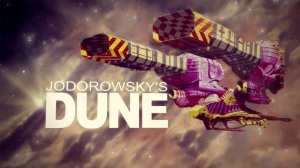
This is a fantastic documentary of a very interesting individual. Alejandro Jodorowsky is from Chile, an actor, filmmaker, and comics writer (among other things). A surrealist, and a mystic. His two most famous movies El Topo and Holy Mountain, are avant-garde even for the seventies.
I found him in this documentary to be very interesting, well spoken, and charismatic, though he does suffer from translation at times – the nuances of his meaning subtly shifted in transferring his thoughts into English.
This film documents the struggles Jodorowsky went through to try and get his version of Dune to the screen, and the profound effects this production had on subsequent Hollywood science fiction movies, even though the film itself was never made.
Alejandro’s attempts to make a movie version of Dune predate the David Lynch Dune, a failed but interesting attempt to film the novel.
Jodorowsky had not read the book prior to embarking on the production, using it as a springboard for many of his own ideas, though he did have some knowledge of the field of science fiction, and had some respect for it as a genre.
For the production, Jodorowsky first enlists the aid of Jean Giraud – Moebius to do the storyboard and design for the movie. The production book of Dune can be seen throughout the documentary, and as an art object it is fantastic, in both sense of the word. Hopefully, someone will publish a copy of this, there are rumours that Taschen is interested. I for one would love to own a copy, as it not only has Moebius’ storyboards, but also conceptual artwork by the next two artists Jodorowsky enlists. In a stroke of near brilliance, Jodorowsky realizing that the various houses have different design esthetics influenced by their core philosophies, Jodorowsky enlists different artists to design different aspects of the movie. Chris Foss, an English artist of science fiction paperback book covers – who designs fantastic and believable ships and architecture – did the concept art for the pirate vessels and the Emperor’s palace, etc. H. R. Giger was enlisted for design work of the House Harkonnen – dark and Gothic imagery to reflect their darkness. The man enlisted to handle special effects was Dan O’Bannon for his work on Dark Star – and he would go on to create the story of Alien, and part of the visual esthetic Giger created for Dune has found its way into the Alien universe. Ridley Scott had no interest in science fiction, being exposed to it primarily through the work of Kubrick in 2001.
Throughout the documentary we see the story unfold through the creative people that Jodorowsy enlists in his spiritual quest to make his trans-formative movie. His plans were ambitious, audacious, and troubling to the prevalent culture of Hollywood, and the project ended up being terminated before filming, even though the script was complete and fully story-boarded, and many of the creative elements had been secured. I have no doubt it would have been an interesting movie, even though it would have been unfaithful to Herbert’s book, but Jodorowsky had to take the material and make it his own.
There is a brilliant montage during the end of this film showing how Moebius’ story board for Dune, which made the rounds of Hollywood, influenced many later science fiction pictures, even though the movie itself never got made.








